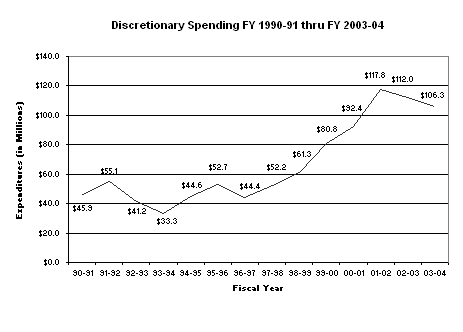Background
At a recent hearing, the Board directed the County Manager to provide a ten-year history of discretionary spending. This information is of particular importance at this time as the Board prepares to address a $30 million budget gap brought about by a stagnant economy, the State budget crisis and increasing costs.
No discussion regarding the calculation of discretionary spending is complete without first reviewing the methodology of the calculation. If fifty analysts were to devise a methodology for calculating discretionary spending for an organization the size of San Mateo County, there would almost certainly be 50 different outcomes. The distinction between discretionary and non-discretionary spending is in and of itself a difficult issue. For instance, the County contributes $8.7 million to the Disproportionate Share Hospital (DSH) program to receive $14 million in return. Though it would be imprudent not to contribute to DSH, it is a discretionary program that the County opts to participate in. On a much smaller scale, the County's discretionary spending for Agricultural programs generates a higher percentage of the State's unclaimed gas tax, so a decrease in spending would be negated by reduced revenues. Perhaps the most difficult area is in the Health and Human Services arena, where the costs for many discretionary but nonetheless important programs are reimbursed up to 70-80%. Depending on the reimbursement rate, $1 million could leverage $2-$3 million for additional services.
The following provides a brief description of the methodology used to calculate discretionary spending for each agency. For the purpose of this analysis, discretionary spending is limited to General Fund expenditures and contributions since most Non-General Fund sources are earmarked for specific purposes with little or no discretion.
Administration and Fiscal
Net County Cost for all discretionary programs, including Memberships and Contributions, plus the Public Safety Sales Tax MOE overmatch for PSC Communications (first calculated in FY 1994-95). Grand Jury and Elections are not included.
Criminal Justice
Public Safety Sales Tax MOE overmatch for the Sheriff, Probation, District Attorney and Coroner's Office. Plus the Net County Cost for the Release on Own Recognizance Program, the Sheriff's North County Investigations Unit at San Francisco International Airport, and the Sheriff's law enforcement support contract with the City of East Palo Alto. The Bar contract for Private Defender Program services is not included.
Environmental Services
Net County Cost for all divisions except LAFCO and the Weights and Measures portion of the Agricultural Commissioner/Sealer budget, plus the contribution to the Library JPA.
Health Services
Net County Cost for all discretionary programs in Administration, Emergency Medical Services and Environmental Health. Net County Cost less various MOE provisions and required matches for Aging and Adult Services, Mental Health and Public Health. Food and Nutrition and In Home Support Services (IHSS) are not included.
Hospital and Clinics
Net County Cost for Hospital and Clinics contributions and Disproportionate Share Hospital payments.
Human Services
Net County Cost for all discretionary programs.
Public Works
Net County Cost for unreimbursed countywide engineering and facility maintenance services (i.e., Childcare Center, Law Library, Old County Courthouse, etc.), the Fair Oaks maintenance agreement, Graffiti Abatement Program and PenTV Media Coordinator.
Non-Departmental
General Fund contributions for capital improvement and countywide automation projects. |
 Discussion Discussion
Our analysis begins with FY 1990-91, continues through the current fiscal year and includes projections for the Recommended FY 2002-03 and FY 2003-04 budgets. Over this period, discretionary spending ranged from a low of $33.3 million or 7.6% of Net Appropriations in FY 1993-94 to a projected high of $117.8 million or 17.1% of Net Appropriations in the current fiscal year. The calculations for the Recommended FY 2002-03 and FY 2003-04 budgets are $112 million (16.0%) and $106.3 million (15.3%) respectively. Actual and projected discretionary spending for the entire 14-year period is $940 million or 13.1% of Net Appropriations.
|
These trends indicate that County discretionary spending is in the neighborhood of 15% of General Fund Net Appropriations, but it is important to remember that because of the way we receive our funding from the State and to some degree the federal government, decreases in discretionary spending may be negated by decreases in revenue so that real savings on reductions may not be on a dollar for dollar basis. A spreadsheet, which details discretionary spending by department, is attached for your review. |
Vision Alignment
This analysis and discussion on discretionary spending prior to budget hearings keeps the commitment to Responsive, Effective and Collaborative Government and goal number 20: Government decisions are based on careful consideration of future impact, rather than temporary relief or immediate gain.
Attachment |